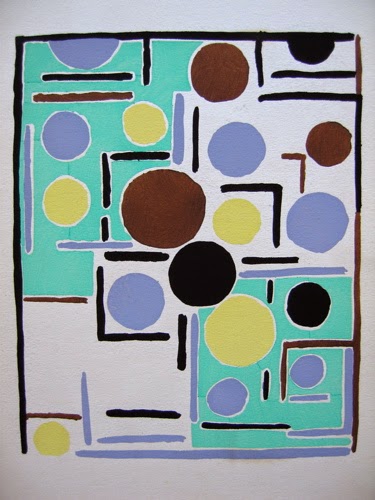Sonia Delaunay was born Sara Stern in 1885 in Odessa in Ukraine, into a relatively-poor Jewish family. At the age of 5 she was adopted by a wealthy uncle, Henri Terk, and renamed Sofia Terk (though she was always known as Sonia). She doesn't appear to have had much if any contact with her birth parents after this point. She grew up in St. Petersburg in wealthy, educated circles, becoming fluent in English, German, and French. In 1904 she went to Germany to study at the Karlsruhe Academy, moving two years later to Paris to study at the Académie de la Palette. Sonia's early paintings, mainly highly-coloured portraits of people in her circle, were influenced by the work of Paul Gauguin, but also by the German Expressionists of Die Brücke, and by the Fauves, who were just exploding onto the Paris art scene. She met and married the art dealer William Uhde, in what was essentially a marriage of convenience; Uhde was gay, and Sonia wanted to stay in Paris. Uhde put on her first show in 1908, but by this time Sonia had already met the love of her life, the painter Robert Delaunay. She and Uhde divorced (though they remained lifelong friends), and Sonia married Robert in 1910. Together they became one of the power couples of the Paris art world, working in a joint style of Cubist-influenced almost abstract colour-contrasts that they named Simultanism or Orphism.

Sonia Delaunay, Composition I
Pochoir from Compositions, Couleurs, Idées, c. 1930
The art of Sonia Delaunay is currently being celebrated in a wonderful exhibition at Tate Modern. This covers the full arc of her career, from those early Gauguin-inspired portraits through the Orphism years right up to her late flowering in the 1960s and 70s, after a period in which she devoted herself to curating Robert's legacy rather than to her own art. One aspect of her work that is particularly well-explored is her move into fabric design and fashion in the 1920s. This was prompted by financial need, as Sonia's income from a property in St. Petersburg vanished with the Russian Revolution, but it played to her natural strengths in manipulating pattern and colour in flowing rhythms.
Sonia Delaunay, Composition II
Pochoir from Compositions, Couleurs, Idées, c. 1930
Sonia Delaunay, Composition VII
Pochoir from Compositions, Couleurs, Idées, c. 1930
Sonia Delaunay, Composition XXVI
Pochoir from Compositions, Couleurs, Idées, c. 1930
The exhibition has many fabric designs, fabric samples, and items of clothing, showing how Sonia Delaunay embraced a kind of total art that could be applied in almost any context, from a Cubist cot quilt for her son Charles to painted bookbindings to costume designs for Diaghilev. The cot quilt is hanging in the same room as my favourite item in the show, the "premier livre simultané", the book
La Prose du Transsibérien et de la Petite Jehanne de France. This 1913 collaboration with her close friend, the poet Blaise Cendrars, consists of a long strip of equally-balanced text and abstract pochoir illustration. Pochoir is an oddly under-explored artistic medium, despite having been used for three of the greatest artist's books of the twentieth century: by Sonia Delaunay in
La Prose du Transsibérien, by Henri Matisse in
Jazz, and by André Lanskoy in Cortège. Besides
La Prose du Transsibérien, Sonia Delaunay employed the pochoir technique to great effect in a portfolio of forty plates published around 1930 under the title
Compositions, Couleurs, Idées. This was published by Éditions d'Art Charles Moreau, and although no limitation is given, the print run was evidently very small, as it has become extremely scarce. Most of the illustrations in this post come from this source.
Sonia Delaunay, Composition XIV
Pochoir from Compositions, Couleurs, Idées, c. 1930
Sonia Delaunay, Composition XV
Pochoir from Compositions, Couleurs, Idées, c. 1930
Sonia Delaunay, Composition XX
Pochoir from Compositions, Couleurs, Idées, c. 1930
Sonia Delaunay, Composition XXXV
Pochoir from Compositions, Couleurs, Idées, c. 1930
Pochoir is a method of hand-stencilling, which became popular in France as a refined method of reproducing watercolour drawings. The products of commercial pochoir ateliers (such as those run by Saudé, Charpentier, and Renson) are often very beautiful, but they aim, as you might expect, for consistency. Sonia Delaunay appears to have applied the pochoir colours herself, and every copy of
La Prose du Transsibérien that I have seen has been quite differently coloured. The one in the Tate exhibition, which is a deluxe copy printed on japon, is hanging next to the original watercolour design, and actually the pochoir colours are much brighter and more vivid. This exercise in synaesthesia has been a great favourite of mine since I first saw a copy in the exhibition Libri Cubisti in Siena in, I think, 1990; I can't lay my hands on the catalogue at present. I even translated Cendrars' long poem about a train journey from Moscow to Paris, purely for the pleasure of accompanying him.
Sonia Delaunay, Témoinage VI
Pochoir for Témoinages pour l'art abstrait, 1952
Sonia Delaunay, Composition with green and blue
Lithograph, 1969
Sonia Delaunay, Composition with a yellow background
Lithograph, 1972
Besides the excellent Tate catalogue, I can recommend Stanley Baron's biography,
Sonia Delaunay: The Life of an Artist, Matteo de Leeuw-de Monti and Petra Timmer,
Colour Moves: Art and Fashion by Sonia Delaunay, and Danielle Molinari,
Delaunay; the latter covers the art of both Robert and Sonia.

















































